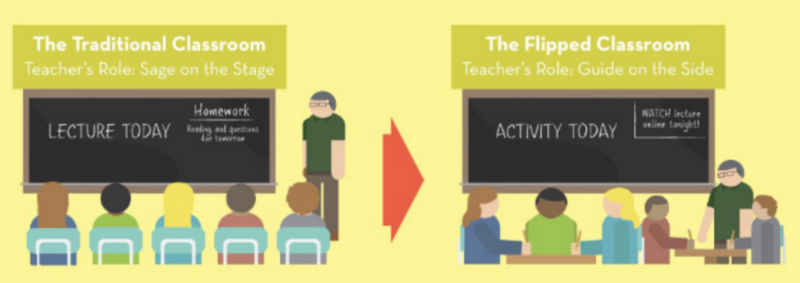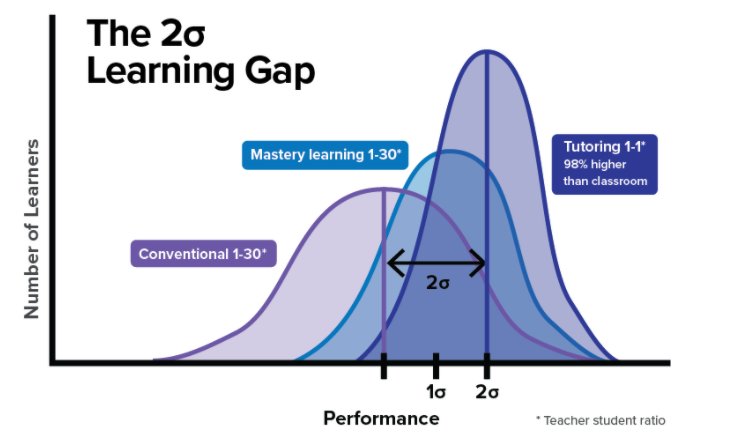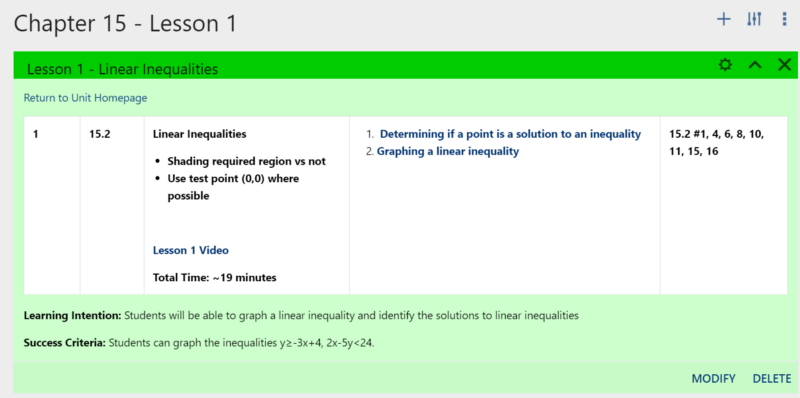Flipping your math classroom: A beginner’s guide

Tips & resources to help you flip your classroom

First, some background on who we are and how we came to be writing this blog…
We’re Elisha and Jonathan. We’re math teachers, education enthusiasts, business colleagues, and life partners (we’re married!)
While we are originally from Canada, we spent four years teaching high school mathematics in Melbourne, Australia. After observing our similar teaching styles and discovering that we were married, our students affectionately nicknamed us ‘Team Templin’.
Now for some background to this blog post, and how we came to be familiar with the flipped classroom: Beyond the teaching math, we both took on major roles with our school’s musical theatre production. While the production was an amazing experience for so many students, it meant we had to miss some classes for rehearsals and preparation. However, getting in a replacement math qualified teacher for our grade 12s was nearly impossible. We both strive to incorporate new and appropriate teaching strategies and wanted to maintain continuity, so this led us to the decision to try a flipped classroom.
We opted to make our own videos as we had experience with video creation, and we used our Learning Management System for organization of the videos, tasks and activities, as students were already familiar with the LMS. It ended up being quite successful and many students said they really preferred being in the driver’s seat for their learning.
Below we go through the “what”, “why” and “how” of a flipped classroom.
Part 1: What is a Flipped Classroom?

In a nutshell, the students will pre-learn the new content mostly independently, often as homework, and then in class the majority of the time is spent practicing, asking questions and doing activities with the teacher there to support.
Let’s start with a baseline. Most teachers familiar with the “Chalk and Talk” or “Direct Instruction” template. The teacher starts by refreshing what they did yesterday, then goes through some new theory and examples on the board, usually seeking student interaction to work through the examples. Then once the students have a nice looking set of notes from the board, they would open up their textbook to a particular page and begin to work through the problems assigned by the teacher and hopefully finish those questions at home for homework. Rinse and repeat.
As a math teacher, we know that practice is very important. However, often the students face challenges when practicing and their teacher isn’t there to help. There are great resources such TVO Mathify in Ontario and WooTube from Australia, and some students have a paid private tutor to help them, but these options can’t replace the attention of the classroom teacher, and tutors are not an option for many students.
The flipped, or inverted, classroom aims to restructure what happens at home and school compared to a more traditional strategy. In a nutshell, the students will first explore new content mostly independently, often as homework, and then in class the majority of the time is spent practicing, asking questions and doing activities in groups or individually, with the teacher there to support.
One common approach is to accessing the learning at home is to create or find video lessons which the students watch. What is great about having video lessons is that students can pause, rewind, and fast forward as desired so they get a lesson pace that is right for them. As they are going, they can take notes and write down questions to ask their teacher. Then in class, students are able to ask questions from the video and work through practice questions with their teacher or their peers there for support. A key component is spending time in class sitting down with students one-on-one, ensuring connections have been made and checking understanding through activities or quizzes. In the third part of this blog post, How to do a Flipped Classroom, you can find resources for making your own videos or finding pre-existing videos to avoid reinventing the wheel when possible. We will also give some resources for activities.
Part 2: Why do a Flipped Classroom?
Flipped classrooms allow for so much more one-on-one time with students, so we can move towards more effective instruction.
Change is hard, so why do a flipped classroom? In short, change can be hard, but effective.
Bloom’s Two Sigma Problem showed us that the best technique for teaching and learning is one-on-one tuition. However, it is indeed a problem as it is just not physically possible to provide every student with one-on-one all the time, so we have stuck with the industrial revolution model of education. Flipped classrooms allow for more one-on-one or small group time with students, so we can move towards more effective, personalized instruction, as less time is dedicated in class to whole group instruction.

In addition to being able to providing more one-on-one support to students, the Flipped Classroom model has another benefit. As a teacher, you will often hear discussions about pace, the tempo at which the lesson moves. Since students work through the content independently they can pause, rewind or fast forward to move at their own pace when watching a video. In addition to being able to work at their own pace through each individual lesson, they can move at their own pace through the unit if desired. This allows students to spend more time on the parts of a concept they need more help with, and less time on what they don’t.
I think my favorite part about doing a Flipped Classroom was being able to intervene immediately when students faced challenges. There is a saying that goes something like, “practice doesn’t make perfect, perfect practice makes perfect.” With a teacher there during practice time, it means that we can intervene at the point of misconception and help students identify and correct errors immediately, rather than having bad habits get ingrained through repeated practice.
Finally, the time to have more engaging activities and personal check-ins made it worth the change.
Part 3: How do I Flip my Classroom?
As a teacher, who doesn’t love resources? Below are a few tools and resources we used when flipping our classrooms.
As we mentioned in the introduction, our motivation for trying a Flipped Classroom was not ideal. We were both teaching a grade 12 subject and were going to be missing about 6 lessons over two weeks for the school production, but there were basically no math qualified replacement/supply teachers, so we wanted to come up with a good solution. It ended up being better than we could have hoped for.
Step 1: Pick a topic
For us, there was a natural topic to start with based on the timing, but you may choose a topic which you think suits the new strategy well. If you aren’t comfortable making your own videos, then maybe look for a topic which has lots of videos already available (more on that later). You don’t need to, and shouldn’t, try to commit to flipping your entire course initially.
Step 2: Create a calendar
No matter your level or strategy for organization, we highly recommend making a calendar to plan out your unit before you start. We found this incredibly helpful for both us and the students. We planned out what topics we would cover each day, where we would have certain activities, and where we would have check-ins. This was for us as much as for the students, but having a set of checkpoints for students allowed them to try and stay on track, even if they were moving at their own pace.
Step 3: Select questions and activities
From step 2, you should have a basic outline of what topics you will cover each day. Consider what your success criteria would be for each lesson and base your practice questions and activities around them. In addition to assigning questions from the textbook which our students had, we would supplement with activities like puzzles, Mathspace or BINGO .
HERE is an example (the key part was the Lesson pages on our LMS)
Below are a few of our favorite places to seek resources:
- Mr. Barton’s Maths: I originally came across this website for Tarsia puzzles, but he has loads of great activities.
- Kuta Software: We were so happy when our school bought a site license, as we had both been using the free worksheets for years. It is great for rote drill type questions.
- TI-nspire: There is a good database of activities related to the CAS calculators.
- Teachers Pay Teacher: A great collection of resources made by teachers for teachers.
- Your Colleagues: I found this to be by far the best place to ask questions and seek support!
Step 4: Find or create video lessons
My first caution if you plan to make your own video lessons, you need to realize what your voice sounds like — you’ll be listening to it a lot. That said, you do not need to make your own as there are so many great resources on YouTube.
Finding Videos
- YouTube: YouTube is probably the best place to start. You can often find what you are looking for by searching for your key terms the search bar.
Here are a few of our favorites:
- WooTube: Eddie Woo has put a camera at the back of his class and records his lesson in Sydney Australia. He’s an awesome teacher and was recently voted one of the Top 10 Teachers in the world! When you watch his videos it feels just like being in his class. His videos are very popular across Australia, and Mathspace has a partnership with him where his videos are organized by course and topic.
- 3Blue1Brown: A soothing voice guides you through neat mathematical topics with excellent animations. Much of this content is very advanced, so is recommended more for extension.
- Khan Academy: A classic. Blackboards with lots of colours are using to provide short instructional videos.
- Math Antics: I haven’t used this one myself, but it’s come recommended from a few teachers I’ve worked with.
- Numberphile: Maybe not the best for instructional material, but really cool! These videos can be great ways to hook students in and engage them.
Making Your Own Videos
We used a variety of different tools and software over the years as we made videos. You can see the progression on our YouTube Channel — Tempeste Mathematics
Here are some of the main things you need to record your own videos:
- A screen recording program
- A tool to create your “presentations” or software
- A webcam (if you intend on having your face visible in the videos)
- A tool to write on the screen, either through a touchscreen or an accessory designed for handwriting. This isn’t strictly necessary, but it definitely makes animating and annotating what you are doing much easier.
Over the years, we used a few different tools to create our videos, which I’ve highlighted below. Most of the tools have their own benefits and drawbacks, so feel free to experiment to find something that fits your style.
Phase 1:
- Production Tools — Electa
- Presentation Software — Microsoft OneNote
- Hardware — Microsoft Surface Pro
- Example — Polynomial Long Division
Phase 2:
- Production Tools — Electa
- Presentation Software — Microsoft PowerPoint
- Hardware — Microsoft Surface Pro or Laptop
- Example — Equations of Tangents
Phase 3:
- Production Tools — Ink2Go, Audacity and Windows Movie Maker
- Presentation Software — Microsoft PowerPoint
- Hardware — Microsoft Surface Pro or Laptop
- Example — Moving Means Smoothing and Interpreting non-linear graphs
Non-Video Content
By no means does the content students are using outside of class need to be videos. It could be a physical textbook, an eBook or a website. An eBook is especially good if it has interactives or built-in videos. We really enjoyed that when we assigned tasks on Mathspace it had practice questions and linked to an eBook which had more video examples, some video lessons and step-throughs for more problems.
Lessons learned
- More videos which were shorted in length were better than one long video!! (more on this in step 5)
- Our students had a bandwidth restriction on their devices at school, but since we just had a white background we could drastically compress the size of the videos using a free video compressor.
- Also related to the bandwidth restriction, our school subscribed to a hosting service called ClickView, so we used this instead of YouTube to house our videos as it would not contribute to student bandwidth usage, and we had better data about which students were engaging in the content and how.
- Some other good tools that we haven’t mentioned above: Screen-cast-o-matic for video recording, Wacom tablets to allow writing on a non-touchscreen device.
Step 5: Organize!
Our school had a Learning Management System (LMS) which students were already familiar with to help us to organize our resources, but this isn’t necessary. A physical calendar or a digital document could suffice. For each lesson, it should be clear to students what is required as full self-direction is challenging for many students. Every lesson started with our learning intention and success criteria, and then from that we made a little template for each lesson with hyperlinks to the videos and content. Below is screenshot example. We didn’t put our Mathspace content on here as there is a built-in calendar on Mathspace which clearly shows the order and timing, but in hindsight I’d probably include everything in there.

Step 6: Explain to students
If students are used to a particular instruction style, change can be hard for them too. It's important to be transparent with them about the changes that are happening, why they're happening, and what the students should expect.
HERE is a little presentation we used to start the unit and get the students on board.
Step 7: Go! Don’t forget to check-in
Ready, set, go! Once students are all set and know what to do, it is time to get started. We found that the preparation was massive, but then the in-class time was really all about the one-on-one check-ins. We were able to dedicate so much more time to each individual student. We spent the majority of the time in classes buzzing about answering questions and would try to fill in the checklist from the presentation in step 6 for each student. We would also spend time working through common errors as a class, doing activities such as BINGO or group tasks to create questions, and doing formative assessments along the way.
This is how we chose to go about it, but there is no one size fits all. Happy teaching!


